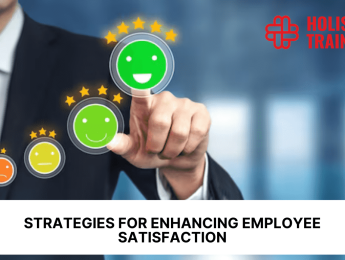- Table of Contents
- Introduction
- What Is Employee Satisfaction?
- Why Is Employee Satisfaction Important?
- Higher Productivity and Performance
- Lower Turnover Rates
- Enhanced Reputation and Attraction of Talent
- Boosted Innovation and Creativity
- Improved Customer Satisfaction
- Cost Savings and Operational Efficiency
- 6 Important Employee Satisfaction Metrics to Measure
- Employee Net Promoter Score (eNPS):
- Job Satisfaction Surveys:
- Employee Engagement Surveys:
- Work-Life Balance Assessments:
- Managerial Effectiveness Surveys:
- Compensation and Benefits Satisfaction:
- 7 Ways to Measure Employee Satisfaction
- 1- Surveys
- 2- Focus Groups
- 3- One-on-One Interviews
- 4- Exit Interviews
- 5- Peer Reviews
- 6- Feedback Platforms
- 7- Observation
- How Is eNPS Calculated?
- 1- Ask the Question:
- 2- Categories Respondents:
- 3- Calculate eNPS:
- Employee Satisfaction Survey Tips
- #1 Anonymity and Confidentiality
- #2 Clear and Concise Questions
- #3 Focus on Actionable Insights
- #4 Use a Mix of Question Types
- #5 Frequency and Timing
- #6 Include a Mix of Positive and Negative Statements
- #7 Involve Employees in Survey Design
- #8 Communicate the Purpose
- #9 Data Analysis and Action Planning
- #10 Continuous Feedback Loop
- Sample Employee Satisfaction Survey
- Challenges in Measuring Employee Satisfaction
- Survey Fatigue
- Anonymity Concerns
- Response Bias
- Interpreting Data
- Inclusivity and Representation
- Dynamic Work Environments
- Cultural and Language Differences
- Lack of Engagement
- Employee Expectations
- 10 Strategies to Improve Employee Satisfaction
- 1- Open and Transparent Communication
- 2- Recognition and Appreciation
- 3- Professional Development Opportunities
- 4- Work-Life Balance Support
- 5- Wellness Programmes
- 6- Effective Leadership and Management
- 7- Employee Feedback Mechanisms
- 8- Continuous Improvement Initiatives
- 9- Team Building and Social Activities
- 10- Fair Compensation and Benefits
- The Impact of Employee Satisfaction on Company Culture and Innovation
- Conclusion
Introduction
Employee satisfaction is a crucial factor in the success of any organisation. Happy employees are more engaged, productive, and likely to stay with their current company, leading to lower turnover rates and higher overall performance. In this guide, we will delve into the world of employee satisfaction, covering what it is, why it's important, how to measure it, and strategies to improve it. So, let's explore the world of employee satisfaction together.
What Is Employee Satisfaction?
Employee satisfaction refers to the contentment and happiness that employees experience in their jobs and with their overall work environment. It is an emotional state that reflects an employee's perception of their job, colleagues, workplace culture, and the organisation as a whole. A satisfied employee is one who feels valued, motivated, and fulfilled in their role.
Why Is Employee Satisfaction Important?
According to a study conducted by theConference Boardin 2021, it was revealed that over 40% of employees expressed dissatisfaction with their jobs. Employee satisfaction is not merely a feel-good metric; it's a cornerstone of organisational success. A satisfied workforce forms the bedrock upon which thriving businesses are built. That being said, let's dive deeper into the profound significance of employee satisfaction:
Higher Productivity and Performance
When employees are satisfied, they are more motivated and engaged in their work. They take pride in their tasks and approach them with enthusiasm. This heightened engagement translates directly into increased productivity. In fact,statistics show that employees who are content in their work environment demonstrate a remarkable 12% increase in productivity levels. Satisfied employees tend to invest their time and energy in their work, leading to improved performance metrics across the board. They are more likely to meet deadlines, exceed targets, and deliver high-quality outputs consistently.
Lower Turnover Rates
High turnover rates can be detrimental to any organisation. It leads to a loss of institutional knowledge, increased recruitment costs, and disruptions in workflow. Satisfied employees are more likely to stay with their current employer. They feel valued and appreciated, making them less susceptible to external job offers. This loyalty significantly reduces turnover rates, ensuring that the organisation retains experienced and skilled staff members, thereby maintaining stability and efficiency.
Enhanced Reputation and Attraction of Talent
A satisfied workforce can be a powerful magnet for top talent. Job seekers often look for companies where employees are happy and fulfilled. Positive word-of-mouth from satisfied employees creates a favourablereputation for the organisation. A strong employer brand not only attracts skilled professionals but also retains existing employees who are proud to be associated with the company. This positive feedback loop strengthens the organisation's position in the job market.
Boosted Innovation and Creativity
Employee satisfaction nurtures a positive work environment where creativity and innovation can flourish. Satisfied employees are more likely to think outside the box, contribute innovative ideas, and take calculated risks. They feel secure enough to share their thoughts without fear of retribution, fostering a culture of innovation. In such an environment, new ideas are welcomed, leading to the development of innovative products, services, and processes that can propel the organisation ahead of its competitors.
Improved Customer Satisfaction
Satisfied employees directly contribute to improved customer satisfaction. When employees are content in their roles, they are more inclined to provide exceptional customer service. Their positive attitude and commitment translate into better interactions with clients, leading to higher levels of customer satisfaction and loyalty. Satisfied employees understand the value of customer relationships, leading to improved customer retention rates and positive customer feedback.
Cost Savings and Operational Efficiency
Organisations with high employee satisfaction levels experience significant cost savings. Reduced turnover rates mean lower recruitment, onboarding, and training costs. Satisfied employees require less supervision, reducing managerial workload. Moreover, their commitment to their work often leads to fewer errors and increased operational efficiency. All these factors contribute to substantial cost savings, enabling the organisation to allocate resources to strategic initiatives and investments.
In essence, employee satisfaction is the linchpin that holds together the various facets of organisational success. It impacts not only the internal dynamics of the workplace but also the external perception and competitiveness of the organisation in the broader market. A satisfied workforce forms the foundation upon which innovation, productivity, and growth thrive, ensuring the organisation's resilience and longevity in an ever-evolving business landscape.
6 Important Employee Satisfaction Metrics to Measure
Measuring employee satisfaction is not a one-size-fits-all endeavour. Organisations employ a variety of metrics to gain a comprehensive understanding of their workforce's contentment and engagement levels. Here are six crucial employee satisfaction metrics, each offering unique insights into different aspects of the work environment:
Employee Net Promoter Score (eNPS):
eNPS is a metric that gauges employees' willingness to recommend their organisation as a great place to work. This score provides a snapshot of overall employee satisfaction. Employees are surveyed with a simple question: "On a scale of 0 to 10, how likely are you to recommend this organisation as a place to work?" Those responding with 9 or 10 are considered promoters, 7 or 8 are passives, and 0 to 6 are detractors. The eNPS is calculated by subtracting the percentage of detractors from the percentage of promoters. A high eNPS indicates a strong level of satisfaction and loyalty within the workforce.
Job Satisfaction Surveys:
Job satisfaction surveys delve into specific aspects of employees' roles, work environment, and relationships within the organisation. Questions often cover topics such as workload, recognition, opportunities for growth, and relationships with colleagues and supervisors. These surveys offer detailed insights into the factors that directly impact employees' day-to-day experiences and overall job satisfaction.
Employee Engagement Surveys:
Employee engagement surveys assess the emotional commitment employees have towards their organisation and its goals. Engaged employees are enthusiastic about their work, motivated to contribute, and align their efforts with the organisation's objectives. These surveys often include questions about work motivation, company values, and how well employees believe their work contributes to the organisation's mission. High engagement levels correlate with increased productivity, creativity, and overall job satisfaction.
Work-Life Balance Assessments:
Work-life balance metrics evaluate employees' perceptions of their ability to balance their professional responsibilities with personal life commitments. It explores factors such as flexible working hours, remote work options, and the organisation's understanding and support for employees' personal obligations. Maintaining a healthy work-life balance is crucial for preventing burnout and ensuring long-term job satisfaction.
Managerial Effectiveness Surveys:
Effective leadership is vital for employee satisfaction. Managerial effectiveness surveys assess employees' relationships with their supervisors, evaluating communication skills, availability, mentorship, and support. Positive relationships with managers often result in higher job satisfaction, increased motivation, and a stronger sense of belonging within the organisation.
Compensation and Benefits Satisfaction:
This metric focuses on employees' perceptions of their compensation packages, benefits, and overall rewards. Questions may cover topics like salary fairness, healthcare benefits, retirement plans, and additional perks offered by the organisation. Competitive and fair compensation, coupled with attractive benefits, contributes significantly to employee satisfaction and retention.
By utilising these diverse metrics, organisations can create a multi-dimensional view of their employees' satisfaction levels. This holistic understanding enables targeted interventions, allowing companies to address specific areas of concern and reinforce positive aspects of the work environment. Consequently, this strategic approach fosters a workplace where employees are not just satisfied but actively engaged, motivated, and eager to contribute to the organisation's success.
7 Ways to Measure Employee Satisfaction
Understanding and evaluating employee satisfaction is fundamental to creating a positive work environment. Employers employ various methods to gather insights into their employees' experiences, concerns, and levels of contentment. Here are seven effective ways to measure employee satisfaction:
1- Surveys
Employee satisfaction surveys are one of the most common and straightforward methods. These surveys consist of carefully crafted questions aimed at understanding different aspects of the work environment. They can be conducted annually, quarterly, or even more frequently, depending on the organisation's needs. The key is to ask specific, relevant questions that provide actionable insights. Utilising an anonymous format encourages honest responses, allowing employees to share their thoughts openly.
2- Focus Groups
Focus groups provide a qualitative approach to understanding employee satisfaction. Small groups of employees from diverse departments and levels within the organisation are brought together for open discussions. A skilled facilitator guides the conversation, encouraging participants to share their thoughts, challenges, and suggestions. Focus groups allow for in-depth exploration of specific topics and can uncover nuanced issues that might be missed in a standard survey.
3- One-on-One Interviews
Individual interviews offer a personalised way to gauge employee satisfaction. Managers or HR professionals can conduct confidential interviews with employees, allowing them to express their feelings and concerns in a private setting. These interviews provide a deeper understanding of individual perspectives and emotions, enabling organisations to address specific needs on a personal level.
4- Exit Interviews
When employees leave the organisation, conducting exit interviews can provide valuable feedback. Departing employees are often more candid about their experiences, shedding light on issues that might have contributed to their decision to leave. Analysing common themes in exit interviews can help organisations identify patterns and implement changes to improve overall employee satisfaction and retention.
5- Peer Reviews
Introducing peer reviews as a part of the evaluation process can offer unique insights into employee satisfaction. Coworkers are encouraged to provide feedback on each other's performance, work ethic, and collaboration skills. Analysing peer reviews can reveal valuable information about team dynamics, communication, and overall job satisfaction within specific departments or teams.
6- Feedback Platforms
Implementing digital platforms or tools specifically designed for gathering employee feedback can enhance communication and engagement. These platforms allow employees to provide continuous feedback on various topics, share suggestions, and even recognise their colleagues' efforts. Real-time feedback fosters a culture of openness and responsiveness, enabling organisations to address concerns promptly and celebrate achievements.
7- Observation
Sometimes, the most telling signs of employee satisfaction are non-verbal. Observing employees' body language, interactions, and overall demeanour in the workplace can provide valuable insights. Engaged and satisfied employees are likely to exhibit positive behaviour, such as active participation in meetings, collaboration with colleagues, and a generally upbeat attitude. Conversely, signs of dissatisfaction, such as disengagement, absenteeism, or lack of enthusiasm, can alert managers to potential issues that require attention.
Combining these methods offers a comprehensive view of employee satisfaction, capturing both quantitative and qualitative data. By employing a variety of techniques, organisations can gain a deeper understanding of their employees' experiences, allowing them to make informed decisions and create a workplace where employees feel valued, supported, and motivated to excel.
How Is eNPS Calculated?
Employee Net Promoter Score (eNPS) is a straightforward metric to calculate. Here's how it's done:
1- Ask the Question:
Use a survey to ask employees the following question: "On a scale of 0 to 10, how likely are you to recommend this organisation as a place to work?"
2- Categories Respondents:
- Promoters (score 9-10):These are enthusiastic employees who are likely to recommend the organisation.
- Passives (score 7-8):These employees are satisfied but not enthusiastic promoters.
- Detractors (score 0-6):These employees are dissatisfied and may have negative opinions about the organisation.
3- Calculate eNPS:
Subtract the percentage of detractors from the percentage of promoters to obtain your eNPS score. The result can range from -100 (all detractors) to +100 (all promoters).
Employee Satisfaction Survey Tips
Conducting an employee satisfaction survey is a powerful tool for understanding your workforce's sentiments. However, the effectiveness of these surveys heavily depends on how they are designed and administered. Here are some essential tips to ensure your employee satisfaction surveys yield meaningful and actionable results:
#1 Anonymity and Confidentiality
Guaranteeing anonymity is crucial to obtaining honest and candid feedback. Employees should feel secure that their responses will remain confidential, encouraging them to express their opinions without fear of repercussions. Clearly communicate the confidentiality measures to build trust among your workforce.
#2 Clear and Concise Questions
Craft survey questions that are clear, concise, and easy to understand. Ambiguous or confusing questions can lead to misinterpretation, affecting the accuracy of the responses. Use straightforward language and avoid jargon to ensure that employees from various backgrounds comprehend the questions uniformly.
#3 Focus on Actionable Insights
Design your questions to gather information that can be acted upon. Instead of asking vague queries, focus on specific aspects of the workplace environment, such as communication, recognition, or workload. The responses should provide insights that guide strategic decisions and initiatives for improving employee satisfaction.
#4 Use a Mix of Question Types
Employ a variety of question types, including multiple-choice, Likert scale (rating scale), and open-ended questions. Multiple-choice questions offer structured data, while Likert scale questions measure intensity of feelings. Open-ended questions allow employees to provide qualitative feedback, offering valuable context to quantitative data.
#5 Frequency and Timing
Consider the frequency and timing of your surveys. Regular, consistent surveys allow you to track changes in satisfaction levels over time. However, be mindful not to over-survey employees, as it can lead to survey fatigue, reducing participation and the quality of responses. Timing is also crucial; avoid conducting surveys during exceptionally busy periods to ensure employees have the time and mental space to provide thoughtful responses.
#6 Include a Mix of Positive and Negative Statements
Balance your survey by including both positive and negative statements. This prevents response bias and encourages employees to evaluate various aspects of their work environment objectively. For example, alongside questions about challenges, include questions about what employees appreciate or find motivating.
#7 Involve Employees in Survey Design
Whenever possible, involve employees in the survey design process. Seek input from representative groups to ensure that the survey addresses relevant concerns and focuses on areas that truly matter to the workforce. This participatory approach can increase survey relevance and employee engagement.
#8 Communicate the Purpose
Clearly communicate the purpose of the survey to your employees. Explain how their feedback will be used to drive positive changes within the organisation. When employees understand that their opinions contribute to meaningful improvements, they are more likely to engage actively and provide thoughtful responses.
#9 Data Analysis and Action Planning
After collecting survey responses, analyse the data thoroughly. Identify patterns, trends, and areas that require attention. Involve relevant stakeholders in the analysis process. Once you have a clear understanding of the data, develop a comprehensive action plan. Address the identified issues, communicate the changes being made, and demonstrate to employees that their feedback has led to positive outcomes.
#10 Continuous Feedback Loop
Establish a continuous feedback loop within the organisation. Regularly communicate the progress made based on the survey feedback. This not only demonstrates your commitment to improving the workplace but also encourages ongoing employee engagement. Moreover, it sets the stage for future surveys, showing employees that their voices continue to shape the organisation.
By incorporating these tips into your employee satisfaction surveys, you not only enhance the quality of the data collected but also foster a culture of openness, trust, and continuous improvement within your organisation. Employees who see that their feedback leads to positive changes are more likely to remain engaged, satisfied, and committed to their roles.
Sample Employee Satisfaction Survey
Here’s a sample survey that you could use to gauge employee satisfaction at your organisation:
Challenges in Measuring Employee Satisfaction
Measuring employee satisfaction is essential, but it comes with its fair share of challenges. Navigating these hurdles is crucial to ensuring accurate, meaningful results that can genuinely drive positive change within an organisation. Here are the common challenges faced when measuring employee satisfaction:
Survey Fatigue
Employees bombarded with surveys may suffer from survey fatigue. If they perceive surveys as repetitive or ineffective, they may respond hastily or even ignore them. This diminishes the quality of responses and undermines the survey's purpose. Organisations must strike a balance, ensuring that surveys are conducted strategically and infrequently enough to maintain employee engagement.
Anonymity Concerns
Despite assurances of anonymity, some employees might fear that their responses could be traced back to them. This fear can lead to guarded or biassed answers, impacting the survey's validity. Building trust within the organisation, especially regarding data confidentiality, is crucial to overcoming this challenge.
Response Bias
Employees might provide socially desirable responses, intending to present themselves or their workplace in a positive light. This response bias can skew the results, offering an inaccurate portrayal of employee satisfaction levels. Crafting questions carefully and encouraging honest, constructive feedback can help mitigate this bias.
Interpreting Data
Interpreting survey data accurately is a challenge in itself. Analysing responses, identifying trends, and discerning actionable insights require expertise. Without skilled data analysis, organisations risk misinterpreting the results and implementing ineffective strategies. Training or involving experts in data interpretation can address this challenge.
Inclusivity and Representation
Ensuring that the survey is inclusive and captures the perspectives of all employees, including those from diverse backgrounds, roles, and levels within the organisation, can be challenging. Inadequate representation may lead to overlooking specific issues faced by certain groups, hindering efforts to create an inclusive work environment.
Dynamic Work Environments
In rapidly changing workplaces, employee satisfaction factors can shift swiftly. Traditional annual surveys might not capture these dynamic changes effectively. Implementing real-time or pulse surveys can address this challenge, providing more frequent insights into employee sentiments and allowing organisations to adapt swiftly to evolving circumstances.
Cultural and Language Differences
In multinational ormulticultural teams, language and cultural nuances can impact survey responses. Certain expressions or sentiments might not translate accurately, leading to misunderstandings. Tailoring surveys to specific cultural contexts and ensuring language accuracy is vital to obtaining meaningful data in diverse workplaces.
Lack of Engagement
Low participation rates can hinder the survey's effectiveness. If employees don't engage actively, the sample size might be insufficient to draw reliable conclusions. To combat this, organisations can employ various engagement strategies, such as transparent communication about the survey's importance, incentives, or even gamification to encourage participation.
Employee Expectations
If employees do not perceive tangible changes resulting from previous surveys, they might question the survey's efficacy. Managing employee expectations and clearly communicating how survey results have influenced organisational decisions and improvements is essential to maintain trust and participation in future surveys.
Overcoming these challenges demands a strategic and thoughtful approach to measuring employee satisfaction. Organisations must be adaptable, transparent, and proactive in their survey methodologies. By addressing these obstacles effectively, organisations can obtain accurate insights, enabling them to create a work environment where employees feel valued, engaged, and satisfied.
10 Strategies to Improve Employee Satisfaction
Now that we've discussed measurement, let's explore strategies to enhance employee satisfaction:
1- Open and Transparent Communication
Foster a culture of open communication where information flows freely between management and employees. Regularly update employees about company news, goals, and challenges. Transparent communication builds trust, making employees feel valued and included in the organisation's journey.
2- Recognition and Appreciation
According to Nectar, a significant 83.6% of employees believe that recognition directly influences their motivation to succeed in the workplace. That’s why it’s important to recognise and appreciate employees' efforts and achievements. Acknowledgement can take various forms, including verbal praise, awards, or a simple thank-you note. Feeling valued and appreciated enhances morale, reinforcing the idea that employees' contributions are crucial to the organisation's success.
3- Professional Development Opportunities
Invest in employee growth and development. Provide opportunities for training, workshops, and skill-building sessions. Supporting employees in their professional growth not only enhances their skills but also demonstrates the organisation's commitment to their well-being and career progression.
4- Work-Life Balance Support
Promote a healthy work-life balance by offering flexible work hours, remote work options, and paid time off. Encourage employees to disconnect from work during their time off. Balance reduces burnout, stress, and exhaustion, ensuring employees return to work rejuvenated and motivated.
5- Wellness Programmes
Implement wellness initiatives that focus on employees' physical and mental well-being. Offer gym memberships, yoga classes, mental health resources, and stress management workshops. Healthy employees are more productive, creative, and resilient, contributing positively to the work environment.
6- Effective Leadership and Management
Provide leadership training to managers and supervisors. Effective leaders inspire, support, and guide their teams. A positive relationship with supervisors significantly impacts job satisfaction. Managers who listen, provide constructive feedback, and recognise achievements create a conducive work atmosphere.
7- Employee Feedback Mechanisms
Establish feedback channels where employees can voice their concerns, suggestions, and ideas. Act on feedback promptly, demonstrating that employee input is valued. Regularly collect feedback through surveys, focus groups, or suggestion boxes, ensuring employees have a platform to express their opinions.
8- Continuous Improvement Initiatives
Implement changes based on employee feedback and evolving workplace needs. Engage employees in improvement initiatives, making them active participants in shaping their work environment. A workplace that continuously evolves in response to employee input is more likely to foster satisfaction and engagement.
9- Team Building and Social Activities
Organise team-building events and social activities that allow employees to interact in a relaxed setting. Strong team bonds foster a sense of belonging and camaraderie, making the workplace a more enjoyable and supportive environment.
10- Fair Compensation and Benefits
Ensure employees receive fair compensation and competitive benefits packages. Periodically review salary structures to ensure they align with industry standards. Additionally, offer benefits such as healthcare, retirement plans, and performance bonuses. A fair and competitive compensation package demonstrates the organisation's recognition of employees' value.
Implementing these strategies requires commitment, consistency, and genuine concern for employees' well-being. By investing in these areas, organisations can create a positive workplace culture where employees feel valued, motivated, and satisfied, leading to increased productivity, lower turnover rates, and overall organisational success.
The Impact of Employee Satisfaction on Company Culture and Innovation
Beyond its direct influence on productivity and turnover rates, employee satisfaction plays a pivotal role in shaping an organisation's culture and fosteringinnovation in the workplace. When employees are content and motivated, they are more likely to engage in collaborative efforts, share ideas, and experiment with new approaches. This positive environment becomes a breeding ground for creativity and innovation, where employees feel empowered to voice their thoughts without fear of criticism.
Innovation thrives in workplaces where employees are encouraged to think outside the box and challenge existing norms. Satisfied employees, feeling secure and supported, are more willing to take risks, propose novel solutions, and explore uncharted territories. A culture of satisfaction not only boosts employee morale but also enhances the organisation's ability to adapt to market changes and technological advancements.
Moreover, satisfied employees often become brand ambassadors, sharing their positive experiences with potential clients, partners, and new hires. This organic promotion not only strengthens the company's reputation but also attracts individuals who resonate with the positive work culture. In essence, a contented workforce acts as the cornerstone upon which a vibrant, innovative, and resilient company culture is built.
Conclusion
Employee satisfaction is a vital aspect of any successful organisation. It directly impacts productivity, turnover, reputation, and overall performance. By measuring employee satisfaction using various metrics and employing effective strategies to improve it, businesses can create a thriving and engaged workforce that contributes to their long-term success. Remember, a satisfied employee is not just an asset; they are the heartbeat of a flourishing organisation.





















